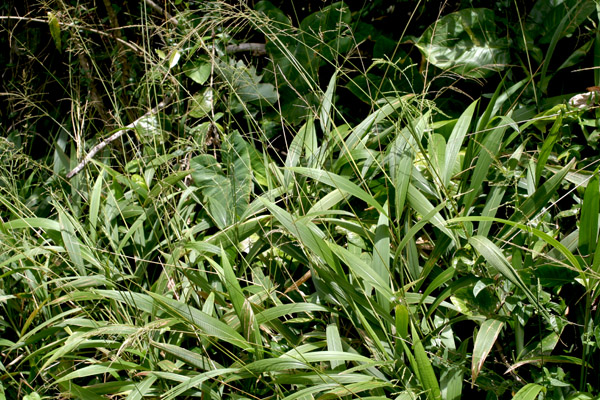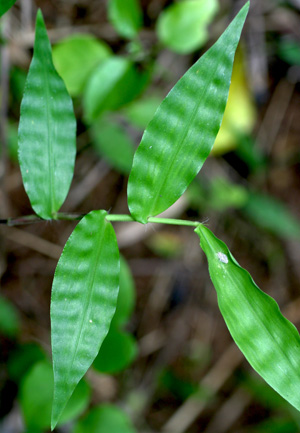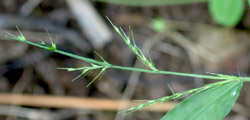|
|
[START OF GRASS KEY]
|
. |
|
. |
|
10a
|
( 9) 9) |
 Large or very large grasses with woody stems (called culms); side branches with leaf blades attached by pseudo-petioles. Basal leaf sheath papery with a small blade at top. Bamboos.
Large or very large grasses with woody stems (called culms); side branches with leaf blades attached by pseudo-petioles. Basal leaf sheath papery with a small blade at top. Bamboos.

|
|
[24]
|
|
10b
|
|
Plant size small, medium, large, or maybe very large, but culms never woody (sclerenchyma may be present for support). Leaf typically consisting of a blade and a basal part (called a sheath; see Fig. 1A at top) clasping the stem, but open along a suture and arising at a node on the culm .. .
If the sheath completely surrounds the culm without a suture (a split down the length of the sheath), consider your specimen may be a sedge.
|
|
[11]
|
|
~~~~ ~~~~~~~~~~~~~~~~~~~~~~~~~
|
|
|
11a
|
(10)
|
Grass unusually robust, large or very large and plant rather coarse in comparison with typical grasses, either reed or cane-like: having a stiff, hollow and jointed stem (although, not hollow in sugar cane) and/or forming very large clumps with or without visible culms; OR if not exceptionally large, then densely clumping and leaves having a strong odor when crushed .. .
|
|
[15]
|
|
11b
|
|
Plant otherwise: size may be delicate to large, but neither cane-like nor an especially large clump; leaves not having a strong odor upon crushing .. . |
|
[12]
|
|
~~~~ ~~~~~~~~~~~~~~~~~~~~~~~~~
|
|
|
12a
|
(11)
|
Leaves linear, with most blades more than 10X longer than wide.
|
|
[20]
|
|
12b
|
|
Leaves longer than wide, but not linear, generally only about 6 times (or less) longer than wide (see Figures 1D and 1E, below)
Young plants may have leaves that are under 10x as long as wide and leaves higher on a culm may also be somewhat stout. Consider only the typical leaves of a mature specimen.
|
|
[13]
|
|
~~~~ ~~~~~~~~~~~~~~~~~~~~~~~~~
[NOTE THREE CHOICES HERE]
|
|
13a
|
(12)
|
Leaves heavy, narrow elliptic, 2 to 3 inches (up to 9 cm) wide and 5 or 6X longer than wide; parallel veins forming prominent ridges on upper leaf surface. { Clump-forming, medium size grass found in lowland, mesic or wet forests and along streams (Fig. 1D). Palmgrass (for its resemblance to palm seedlings) [HAW - NAT] [FAC]Setaria palmifolia (J. König) Stapf
|
|
|
|

Figure 1D. Palmgrass (Setaria palmifolia) in flower.
|
|
13b
|
|
 Leaves 1 to nearly 6 in (2-15 cm) long, usually 1/2 in (1 cm) to 1 in (2.5 cm) across, surface smooth but wavy (Fig. 1E). { Sprawling grasses common to abundant in shaded locations.
Leaves 1 to nearly 6 in (2-15 cm) long, usually 1/2 in (1 cm) to 1 in (2.5 cm) across, surface smooth but wavy (Fig. 1E). { Sprawling grasses common to abundant in shaded locations.
Figure 1E (left). Leaves of basketgrass, Oplismenus hirtellusFigure 1F (below). Flowering head of O. hirtellus with awned spikelets arranged on racemes.

|
|
[14]
|
|
13c
|
|
Plant habit creeping, closely resembling Oplismenus but leaves not wavy. Spikelet slightly compressed; no awn. [HAW -NAT] Cyrtococcum patens (L.) P. Beauv.
The spikelets closely resemble those of common milett, a stout, grass with a vertical culm and spikelets rounded not compressed.
|
|
~~~~ ~~~~~~~~~~~~~~~~~~~~~~~~~
|
|
|
14a
|
(13)
|
Spikelets (compact cluster of flowers on a lateral stem, see Page 4) on lowest raceme no more than 3/16 in (4 mm) apart. Leaves to nearly 4 in (5-10 cm) long, usually about 1/2 in (1 cm) but less than 3/4 in (2 cm) across. { Small, sprawling grasses common to abundant on forest floors in lowland mesic forests. Basketgrass or hohono kukui. (Figs. 1E, 1F) [HAW -NAT] [FAC] [GUM - IND]Oplismenus hirtellus (L.) P. Beauv.
|
|
|
|
14b
|
|
Spikelets on lowest raceme from 3/16 to 1/2 in (4 to 12 mm) apart. Leaves 1 to 6 in (2-15 cm) long, about 1/2 in (1 cm) to 1 in (2.5 cm) across. { Small, sprawling grasses common on forest floors in mesic forests above 800 ft (245 m) elevation. [HAW -NAT] [FACU] [GUM - IND] [FACU] Oplismenus compositus (L.) P. Beauv.
|
|
|